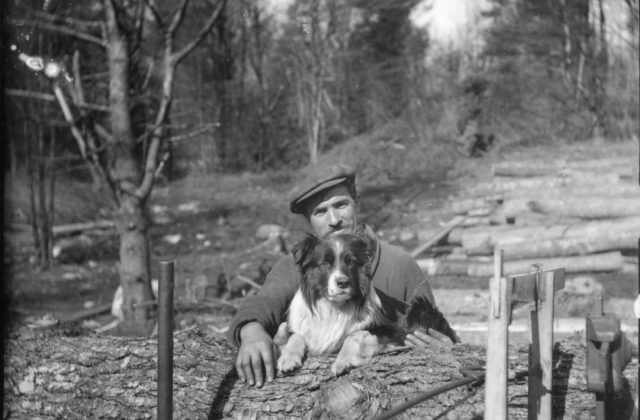Every Picture Tells A Story
A photographic exhibit captures a past
By Veronica Burns
The work they did might have been mundane, the business of cutting down trees and hauling off heavy logs for the lumber industry, but the photographs that depict them carrying out this work are anything but. “This great find,” as Norfolk Historical Society president, Barry Webber, describes it, is the photographic exhibit currently showing in the Norfolk Library. The exhibit, “Lost in the Greenwoods,” is a collaboration between the historical societies of Norfolk and Colebrook and features 35 prints. Webber heard about a box of glass plate negatives that were languishing in an attic in West Hartford and when he called he heard that the bought had been purchased at auction. “It weighs a ton,” Webber was told, “we’d be glad to get rid of it.” Webber collected the box last January, “knowing that they were interesting artifacts.” The wooden box contained 250 sleeved 4 x 5-inch glass plate negatives.
The task of printing them for the exhibit was undertaken by Norfolk photo historian and photographer, Michaela Murphy. “There is a wonderful, unencumbered quality to these photographs,” says Murphy. “The images are not stilted. They are posed yet not posed,” she says, referring to the willing way in which the subjects look into the camera.
 The result is a fascinating narrative of a group of people pictured in a time of transition in the early 1920’s. The men, women and children, plus their various animals, can be seen in what Murphy describes as ‘professional-quality photographs.’ The photographer is unknown and the question of whether the photos were taken by a man or woman is the subject of debate. “I don’t think there is a masculine or feminine way to look at things,” says Murphy, though she surmises that the picture of the women swimming was possibly taken by a woman, maybe the wife of the photographer. Both Norfolk and Colebrook historical societies are hopeful that there will be feedback during the exhibit and from the publicity surrounding it, so that more will become known. So far, two people in the photos have been identified.
The result is a fascinating narrative of a group of people pictured in a time of transition in the early 1920’s. The men, women and children, plus their various animals, can be seen in what Murphy describes as ‘professional-quality photographs.’ The photographer is unknown and the question of whether the photos were taken by a man or woman is the subject of debate. “I don’t think there is a masculine or feminine way to look at things,” says Murphy, though she surmises that the picture of the women swimming was possibly taken by a woman, maybe the wife of the photographer. Both Norfolk and Colebrook historical societies are hopeful that there will be feedback during the exhibit and from the publicity surrounding it, so that more will become known. So far, two people in the photos have been identified.
The exhibit displays evocative images of stoic, hardworking men and equally hardworking animals. The images can be gentle, as the one showing a woodpecker being held in the palm of a woman’s hand, while another, titled ‘Dave with the Colonel and Matt’ shows a man standing at the head of his two work horses, hand firmly grasping the reins and all three looking tired from a day’s work. ‘Pete and Prince’ is a crowd favorite. “This is a beautifully composed picture”, says Bob Griggs, historian for the town of Colebrook and co-curator of the exhibit, “these are rough guys and here you look at Pete and he is showing his inner soul. He holds the dog gently. Obviously he loved the dog.” Webber also claims this as a favorite. “I love the giant paws of the dog, and the giant hand of the man, side by side.” Many of the people in the photos are not named, but lots of the animals are. Colonel, Matt, Rog and Dick are horses. Wink and Prince are dogs. There is a cat named Bastu. Of the human subjects, two females command attention. “Beans” appears as a young girl and can also be seen in a series of photos as she ages from about five to 20. “Lu” is an older woman who in one photo is sitting with the guys on a huge oak log, and in another is posing in the doorway of what might be her home. Behind her on the wall loom the tools of the logging trade, several large-toothed saws.
What makes the exhibit particularly interesting to Griggs is the “very small historical window” that the photos illustrate. Lumbering had been relatively unchanged since medieval times but by 1920 small transportable engines had been introduced into the industry and can be seen in the photographs. “The horses in the pictures were also nearing the end of their reign” says Griggs, “in another 15 to 20 years the Caterpillar would replace the horse.”
In her informative notes to the photographs, Murphy writes ‘They are more than stories, they are history. They are more than history, they are stories.’ And stories they will be until there is more information. “It’s all assumption right now,” says Webber, “Maybe someone out there can help us discover the true story. Otherwise, it will all remain a mystery.”
The organizers of the exhibit, which will run through January, are planning a round table event at the Library on January 9. This presentation will hopefully shed even more light on the photographs and the subjects.

